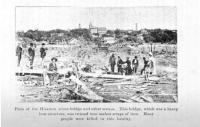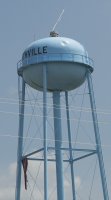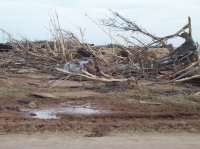I'll have to break this into a few posts because apparently there's a limit to the number of photos per post.
It's an interesting question, even though we'll never be able to do more than speculate. The most likely candidate for most violent tornado ever recorded is likely one we'd never suspect. Consider how many large, potentially violent tornadoes form every year and simply don't strike anything of note during their lifespan, and then consider how many
other potentially violent tornadoes just don't happen to hit anything substantial while they're at their most violent. It's extremely unlikely that the most violent tornado to ever form would have actually crossed paths with a structure that could record such violent damage, much less done so at peak intensity.
But, moving past that, I think there are basically two ways to look at candidates for "most violent." Both of them obviously involve evaluating damage in some way since, except in rare cases where we have mobile radar obs, the resulting damage (with all the problems and inconsistencies that entails) is the only useful proxy we really have for intensity. So, the first category to consider is tornadoes that caused the most intense individual instance(s) of damage. There are many, many tornadoes that could fall under this criteria, but there are several that immediately come to mind for me (not necessarily in order).
May 27, 1997 - Jarrell, TX
The poster boy for truly complete devastation; damage simply does not get more intense than what the Jarrell tornado produced in and around Double Creek Estates. Every home in the core of the tornado's path was swept completely away, the debris ground up into woodchip-sized pieces and scattered for hundreds of yards. The survival rate in the core of the tornado was zero. The ground scouring was probably the most intense ever documented, with the soil scoured out to a depth of more than one foot in some places. Grassy fields and front lawns were reduced to nothing more than mud. I won't recount the full aftermath of this tornado, but I
wrote an article (including lots of photos) if anyone is unfamiliar.
There's an argument that the slow forward speed may have played a significant role in the damage caused, and that may be the case. However, I think there are almost always other factors beyond pure wind speed that contribute to the amount of damage a tornado causes, so I'm not sure forward speed is relevant. Also, we've seen plenty of tornadoes with similarly slow forward speed, and yet none of them has caused the same level of damage as Jarrell. One thing that I think
did play a big role was the tremendous amount of dirt, sand and rocks scoured from the ground, which likely produced the "sandblasting" effect noted in Jarrell.
June 1, 1990 - Bakersfield Valley, TX
Almost always overlooked due to the very remote, rural area in which it occurred, I think the Bakersfield Valley tornado belongs on any list of most intense tornadoes. This tornado averaged nearly 3/4 mile wide, reaching a max width of 1.3 miles. It's officially rated F4 because it only impacted a few structures. Two people were killed when they separately drove into the heavily rain-wrapped multivortex tornado and their vehicles were thrown from the road. This tornado produced tremendous ground scouring, leaving nothing left but dirt, rocks and a few stripped and mangled mesquite stumps. Three hundred feet of asphalt was stripped from a nearby road. Three oil tanks, full of oil and weighing between 70 and 90
tons, were torn from their battery and tossed/rolled/tumbled three miles. Two of the tanks came to rest 600 feet up the side of a hill with a 40º incline, and the other tank was actually rolled up and over the other side of the hill. Before the tornado became heavily rain-wrapped, witnesses described it as looking very similar to the 1979 Wichita Falls tornado.

At left is an aerial view of the tornado's path, which is clearly visible as a streak through the center of the image due to the extraordinary scouring. At right is a ground-level photo showing virtually nothing left but dirt and rocks. This was previously a field. The photos are poor quality but you get the idea.

Also hard to see, but this is the road from which 300+ feet of asphalt was scoured.

A heavy steel anhydrous ammonia tank which was torn from its anchoring and rolled some distance by the tornado.
Incidentally, another potentially extremely violent but little-known tornado struck just two weeks later. On June 15, 1990, a monster tornado (up to 1.5 miles wide) struck largely rural areas of Hitchcock and Red Willow Counties in Nebraska. It leveled a handful of homes, but it also did incredible damage to a number of vehicles and farm equipment. In many cases these vehicles literally disappeared, with only pieces and parts remaining scattered for many miles. Dean Cosgrove has some incredible photos and more of the story on this tornado, and the June 1990 issue of Storm Data has info on both of these tornadoes
http://windsweptchasetours.com/JUNE_15_1990_Damage.html
May 15, 1896 - Sherman, TX
Given that it took place well over 100 years ago, reliable details are somewhat scarce. What we do know, however, is extremely impressive. The Sherman tornado was very narrow - the worst of the damage often only 50-100 yards wide - but the damage was very intense. There was pronounced ground scouring, with one reporter stating "not one tree, shrub or blade of grass was left." The Houston Street bridge, an iron bridge weighing "hundreds of thousands of tons," was said to have been torn from its anchoring and twisted into unusable scraps. Railroad tracks on the edge of town were reportedly torn up and twisted. Virtually every home in the path was completely swept away, and in some cases whole families were killed. Victims were badly mangled and dismembered.












































